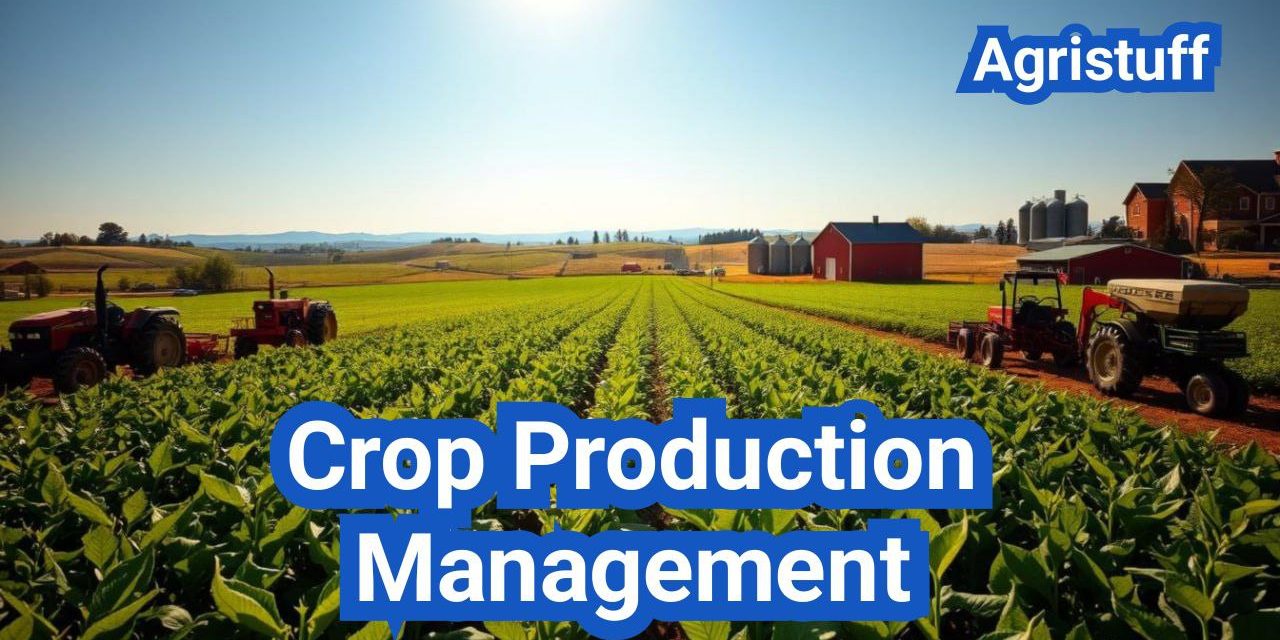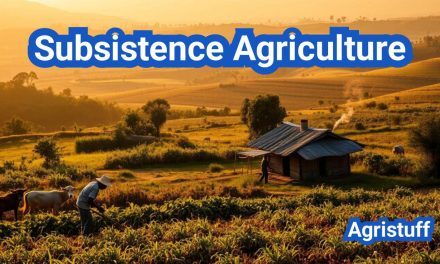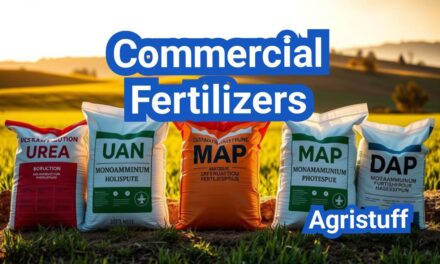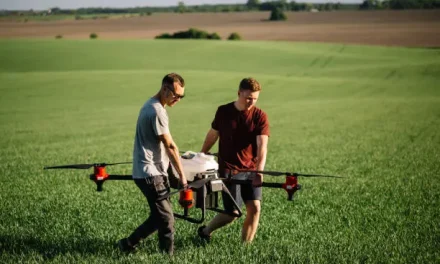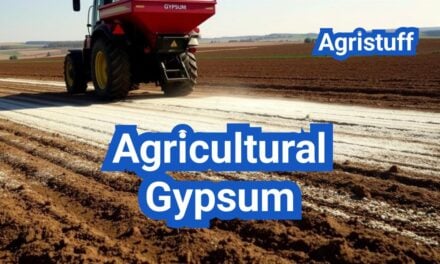Efficient agricultural practices are crucial for improving yields and quality in farming. Effective crop management involves various practices, including soil preparation, seed selection, and irrigation.
The use of crop management software has become increasingly important in modern farming, enabling farmers to make data-driven decisions and optimize their agricultural productivity.
Sustainable practices are also vital for long-term success, ensuring that farming methods are environmentally friendly and economically viable.
Key Takeaways
- Effective crop management is crucial for improving agricultural productivity.
- Crop management software enables data-driven decision-making.
- Sustainable practices are vital for long-term farming success.
- Integrated crop management practices enhance overall farm management.
- Agricultural productivity is directly linked to efficient farming methods.
The Science of Crop Production Management
The science behind crop production management involves a complex interplay of various factors that influence crop yields and quality. Effective crop production management is not just about growing crops; it’s about creating a sustainable agricultural practice that maximizes productivity while minimizing environmental impact.
Defining Crop Production Management
Crop production management refers to the processes and practices used to plan, execute, and monitor agricultural production. It encompasses a wide range of activities, including soil preparation, seed selection, irrigation management, and the application of fertilizers and pest control measures.
Key aspects of crop production management include:
- Soil health management
- Crop selection and rotation
- Irrigation and water management
- Nutrient management
- Pest and disease management
Key Components of Successful Crop Production
Successful crop production is contingent upon several key components. These include:
| Component | Description | Importance |
|---|---|---|
| Soil Preparation | Preparing the soil to optimize its structure and fertility | High |
| Crop Selection | Choosing crops that are suitable for the local climate and soil conditions | High |
| Irrigation Management | Applying the right amount of water at the right time | Medium to High |
| Nutrient Management | Applying fertilizers and other nutrients as needed | Medium to High |
Economic Impact of Effective Management
Effective crop production management can have a significant economic impact on farming operations. By maximizing yields and improving crop quality, farmers can increase their revenue. Additionally, efficient management practices can reduce costs associated with inputs like water, fertilizers, and pest control.
Economic benefits include:
- Increased crop yields and quality
- Reduced input costs
- Improved profitability
- Enhanced competitiveness in the market
By adopting best practices in crop production management, farmers can not only improve their economic outcomes but also contribute to sustainable agricultural development.
Soil Preparation and Analysis
The foundation of successful crop production lies in soil preparation and analysis, critical components that determine the overall health and fertility of the soil.
Soil Testing Methods | Crop Production Management
Soil testing is a crucial step in understanding the soil’s nutrient levels, pH, and other characteristics that impact crop growth. Various methods are employed for soil testing, including:
- Grid sampling: This involves dividing the field into grids and collecting soil samples from each grid.
- Zone sampling: Soil samples are collected based on different zones within the field, often determined by soil type or historical yield data.
- Composite sampling: Multiple soil samples are combined to form a single sample representative of the field.
Table: Soil Testing Methods and Their Applications
| Testing Method | Description | Application |
|---|---|---|
| Grid Sampling | Divides the field into grids for sample collection | Ideal for fields with uniform soil types |
| Zone Sampling | Sampling based on different field zones | Useful for fields with varied soil conditions |
| Composite Sampling | Combining multiple samples into one | Provides a general overview of soil conditions |
Tillage Techniques and Their Impact
Tillage techniques significantly affect soil structure, fertility, and overall health. Different tillage methods include:
- Conventional tillage: Involves intensive tillage that can disrupt soil structure.
- Conservation tillage: Reduces soil disturbance, preserving organic matter and reducing erosion.
- No-till farming: Eliminates tillage altogether, promoting soil health and reducing fuel consumption.
Improving Soil Structure and Fertility | Crop Production Management
Enhancing soil structure and fertility is vital for optimal crop production. Strategies include:
- Adding organic matter: Incorporating compost or manure to improve soil structure and nutrient content.
- Crop rotation: Rotating crops to utilize different nutrient profiles and improve soil health.
- Cover cropping: Planting cover crops to protect and enhance the soil during off-seasons.
By implementing these strategies, farmers can significantly improve soil health, leading to better crop yields and more sustainable agricultural practices.
Seed Selection and Planting Strategies

Effective seed selection is the cornerstone of successful crop production, directly influencing yield and quality. The choice of crop variety is critical, as it determines the potential for optimal growth and resilience to environmental stresses.
Choosing the Right Crop Varieties | Crop Production Management
Selecting the appropriate crop variety is influenced by factors such as climate, soil type, and the presence of pests or diseases. High-quality seeds that are resistant to common pests and diseases can significantly improve crop yields. For instance, crop varieties bred for drought tolerance can be advantageous in regions prone to water scarcity.
“The right seed selection can make all the difference in crop production,” emphasizes the importance of this initial step in the agricultural process.
Understanding Hardiness Zones | Crop Production Management
Hardiness zones are geographical areas defined by their average annual extreme minimum temperature, which is a crucial factor in determining which plants can thrive in a given region. Understanding the hardiness zone of your farm or field is essential for selecting crop varieties that are adapted to the local climate conditions.
Optimal Planting Techniques | Crop Production Management
Optimal planting techniques vary depending on the type of crop, soil condition, and available equipment. Techniques such as precision planting can enhance seed placement accuracy, improve germination rates, and reduce waste. Additionally, considering factors like soil moisture and temperature at planting time can significantly impact crop establishment and early growth.
By combining the right seed selection with an understanding of hardiness zones and employing optimal planting techniques, farmers can significantly enhance their crop production management practices, leading to improved yields and better resource utilization.
Water Management and Irrigation Systems
Optimizing water use through advanced irrigation systems is essential for sustainable agriculture. Effective water management is critical for crop production, as it directly impacts crop health, yield, and quality.
Assessing Water Requirements | Crop Production Management
Understanding the water requirements of crops is fundamental to efficient irrigation. Factors such as soil type, climate, and crop variety influence water needs. Soil moisture monitoring is a valuable technique for determining when irrigation is necessary.
Types of Irrigation Methods | Crop Production Management
Various irrigation methods are available, each with its advantages and suitability for different conditions. Common types include drip irrigation, sprinkler irrigation, and flood irrigation. The choice of method depends on factors like crop type, soil characteristics, and water availability.
Smart Irrigation Systems | Crop Production Management
Smart irrigation systems represent a significant advancement in water management. These systems utilize technology such as sensors and data analytics to optimize irrigation. By monitoring soil moisture levels, weather forecasts, and crop water requirements, smart irrigation systems can significantly reduce water waste.
Water Conservation Strategies | Crop Production Management
Implementing water conservation strategies is crucial for sustainable agriculture. Techniques such as mulching, cover cropping, and using drought-tolerant crop varieties can help reduce water usage. Additionally, optimizing irrigation scheduling based on weather forecasts and soil moisture levels can further conserve water.
Nutrient Management for Optimal Crop Growth

Managing nutrients effectively is key to enhancing crop productivity and sustainability. Nutrient management involves a comprehensive approach to ensuring crops receive the necessary nutrients for healthy growth.
Essential Plant Nutrients | Crop Production Management
Crops require a variety of nutrients to grow, including macronutrients like nitrogen, phosphorus, and potassium, and micronutrients such as zinc and iron. Balanced nutrient supply is crucial for optimal growth and development.
Fertilizer Application Techniques | Crop Production Management
The method of fertilizer application can significantly impact crop yields. Techniques include broadcasting, banding, and fertigation. Precision application methods help minimize waste and environmental impact.
Organic vs. Synthetic Fertilizers | Crop Production Management
The debate between organic and synthetic fertilizers centers on their effects on soil health and crop productivity. Organic fertilizers, derived from natural sources, improve soil structure and promote beneficial microbial activity. Synthetic fertilizers, while providing immediate nutrient availability, can lead to soil degradation if not managed properly.
| Characteristics | Organic Fertilizers | Synthetic Fertilizers |
|---|---|---|
| Nutrient Release | Slow release | Immediate availability |
| Soil Impact | Improves soil structure | Potential for soil degradation |
| Environmental Impact | Lower environmental impact | Higher risk of pollution |
“The use of organic fertilizers can enhance soil fertility and structure, promoting a more sustainable agricultural practice.”
— Dr. Jane Smith, Soil Scientist
Soil Nutrient Monitoring
Regular monitoring of soil nutrients is essential to adjust fertilizer applications accordingly. Techniques include soil testing and plant tissue analysis. Accurate monitoring helps prevent over-fertilization and ensures optimal nutrient levels.
Integrated Pest Management Strategies
Crop protection is a significant challenge in agriculture, and integrated pest management (IPM) offers a comprehensive solution. IPM involves a combination of techniques to manage pests, ensuring that agricultural practices are both effective and sustainable.
Identifying Common Crop Pests | Crop Production Management
The first step in IPM is identifying the pests that can damage crops. Common crop pests include insects like aphids, caterpillars, and beetles, as well as nematodes and rodents. Accurate identification is crucial because different pests require different management strategies.
- Aphids: Small, soft-bodied insects that feed on plant sap.
- Caterpillars: Larval stage of butterflies and moths, often causing significant damage by eating leaves and fruits.
- Beetles: A diverse group with many species that can be harmful to crops.
Preventive Pest Control Measures | Crop Production Management
Preventive measures are essential in IPM to reduce the likelihood of pest infestations. These measures include:
- Crop rotation: Rotating crops to break the life cycle of pests.
- Resistant varieties: Planting crop varieties that are resistant to certain pests.
- Sanitation: Removing weeds and debris that can harbor pests.
- Quarantine: Preventing the introduction of pests into new areas.
Chemical and Biological Control Methods | Crop Production Management
When preventive measures are not enough, chemical and biological control methods are employed. Chemical control involves the use of pesticides, while biological control involves using living organisms or their products to control pests.
Monitoring and Assessment Techniques | Crop Production Management
Monitoring and assessment are critical components of IPM. Regular monitoring helps in early detection of pest infestations, allowing for timely intervention. Techniques include:
- Field scouting: Regularly inspecting fields for signs of pests.
- Trap cropping: Planting crops that attract pests away from the main crop.
- Using technology: Employing tools like drones and satellite imaging to monitor crop health.
By integrating these strategies, farmers can effectively manage pests, reduce crop losses, and promote sustainable agricultural practices.
Effective Weed Management Techniques

Effective weed management is crucial for maintaining healthy crops and maximizing yields. Weeds compete with crops for water, nutrients, and light, potentially reducing crop productivity and quality.
Weed Identification and Classification | Crop Production Management
The first step in effective weed management is accurate identification and classification of weeds. Understanding the types of weeds present in a field allows farmers to choose the most appropriate control methods. Weeds can be broadly classified into annuals, biennials, and perennials, each requiring different management strategies.
Mechanical Weed Control | Crop Production Management
Mechanical weed control methods involve physically removing or destroying weeds. Techniques include hand weeding, hoeing, and using machinery such as cultivators or mowers. These methods are effective for small areas or for crops that are sensitive to herbicides.
Chemical Weed Management | Crop Production Management
Chemical weed management involves the use of herbicides to control weeds. Herbicides can be selective, targeting specific weed species, or non-selective, killing a wide range of plants. The choice of herbicide depends on the crop being grown, the types of weeds present, and environmental considerations.
Integrated Weed Management Approaches | Crop Production Management
Integrated weed management (IWM) combines different control methods to manage weeds effectively and sustainably. IWM strategies may include cultural practices (such as crop rotation and cover cropping), mechanical control, chemical control, and biological control methods. By integrating multiple approaches, farmers can reduce their reliance on any single method, minimizing the risk of developing herbicide-resistant weed populations.
Implementing IWM requires a comprehensive understanding of the weed species present, the crop production system, and the local ecosystem. It also involves monitoring weed populations and adjusting management strategies as needed.
Crop Rotation and Diversification

Crop rotation and diversification strategies are vital for maintaining healthy ecosystems, improving crop yields, and reducing environmental impact. By rotating crops, farmers can break disease and pest cycles, improve soil fertility, and increase biodiversity.
Benefits of Crop Rotation | Crop Production Management
Crop rotation offers numerous benefits, including improved soil health, reduced pest and disease pressure, and increased crop yields. By changing the type of crops grown on a particular field, farmers can break the life cycle of pests and diseases, reducing the need for chemical pesticides and fertilizers.
- Enhanced soil fertility through nitrogen fixation and improved soil structure
- Reduced soil erosion due to varied root depths and crop residues
- Increased biodiversity, supporting a wider range of beneficial insects and microorganisms
Planning Effective Rotation Cycles | Crop Production Management
Planning effective crop rotation cycles requires careful consideration of crop selection, soil type, and climate conditions. A well-planned rotation can help maintain soil health, optimize nutrient use, and reduce pest and disease pressure.
| Crop Type | Benefits | Rotation Considerations |
|---|---|---|
| Legumes | Nitrogen fixation, improved soil fertility | Rotate with non-legume crops to maximize nitrogen benefits |
| Cereals | Soil erosion control, weed suppression | Alternate with broadleaf crops to break disease cycles |
| Brassicas | Pest and disease disruption, soil health improvement | Rotate with non-Brassica crops to avoid disease buildup |
Companion Planting Strategies
Companion planting is a valuable strategy in crop rotation, where different crops are grown together to improve growth, health, and productivity. This approach can enhance biodiversity, reduce pests and diseases, and improve soil health.
Examples of Companion Planting:
- Planting marigolds with tomatoes to deter nematodes
- Growing basil with tomatoes to improve flavor and repel pests
- Using nasturtiums as a trap crop to protect brassicas from aphids
Cover Crops and Their Advantages
Cover crops are an essential component of crop rotation and diversification strategies. They provide numerous benefits, including soil erosion control, improved soil health, and enhanced biodiversity.
Some advantages of cover crops include:
- Reducing soil erosion through root growth and soil cover
- Improving soil fertility through nitrogen fixation and organic matter addition
- Supporting beneficial insects and microorganisms
Digital Tools for Crop Production Management

The advent of digital tools has revolutionized crop production management, offering farmers unprecedented insights and control. These tools have become essential for modern farming, enabling farmers to optimize crop yields, reduce waste, and improve sustainability.
Crop Management Software Solutions
Crop management software solutions are designed to help farmers manage their crops more effectively. These solutions provide a range of features, including crop monitoring, yield prediction, and soil analysis. By leveraging these tools, farmers can make informed decisions about planting, irrigation, and harvesting.
Some of the key benefits of crop management software include:
- Improved crop yields through data-driven decision making
- Enhanced resource allocation and reduced waste
- Better management of pests and diseases
Crop Monitoring and Tracking Applications
Crop monitoring and tracking applications are another crucial digital tool for crop production management. These applications allow farmers to monitor their crops in real-time, tracking factors such as temperature, moisture levels, and growth rates. This information enables farmers to respond quickly to changes in crop conditions, reducing the risk of crop failure.
Farm Management Information Systems
Farm Management Information Systems (FMIS) are comprehensive software solutions that integrate various aspects of farm management, including crop production, livestock management, and financial management. FMIS provide a centralized platform for farmers to manage their operations, making it easier to track performance and make strategic decisions.
Data-Driven Decision Making
One of the key advantages of digital tools in crop production management is the ability to make data-driven decisions. By collecting and analyzing data on crop performance, weather patterns, and soil conditions, farmers can optimize their management practices, leading to improved yields and reduced environmental impact.
| Digital Tool | Key Features | Benefits |
|---|---|---|
| Crop Management Software | Crop monitoring, yield prediction, soil analysis | Improved crop yields, reduced waste |
| Crop Monitoring Applications | Real-time monitoring, temperature tracking, growth rate analysis | Quick response to crop changes, reduced risk of crop failure |
| Farm Management Information Systems | Integrated farm management, crop and livestock tracking, financial management | Centralized management, improved performance tracking |
Precision Agriculture Technologies

Precision agriculture is at the forefront of modern farming, enhancing productivity and sustainability. By leveraging advanced technologies, farmers can now manage their crops more effectively, reducing waste and improving yields.
GPS and GIS Applications
Global Positioning System (GPS) and Geographic Information System (GIS) technologies are crucial in precision agriculture. GPS allows for accurate navigation and mapping of fields, while GIS provides a framework for analyzing and displaying geographically referenced data. Together, they enable farmers to make informed decisions about planting, irrigation, and harvesting.
Key Applications of GPS and GIS:
- Field mapping and soil sampling
- Precision planting and yield monitoring
- Irrigation management and crop monitoring
Variable Rate Technology
Variable Rate Technology (VRT) allows farmers to apply inputs such as fertilizers, pesticides, and irrigation at varying rates across a field. This is achieved through the use of GPS, GIS, and sensor technologies to optimize crop production.
The benefits of VRT include:
- Reduced input costs
- Improved crop yields
- Minimized environmental impact
Remote Sensing and Drones
Remote sensing technologies, including drones equipped with multispectral or hyperspectral cameras, provide valuable insights into crop health and development. These technologies enable early detection of issues such as pest infestations, disease outbreaks, and nutrient deficiencies.
“The use of drones in agriculture has revolutionized the way we monitor and manage crops. With the ability to capture high-resolution images, farmers can now identify problems early and take corrective action.” – John Deere
Soil Sensors and IoT Devices
Soil sensors and Internet of Things (IoT) devices play a vital role in precision agriculture by providing real-time data on soil moisture, temperature, and other parameters. This information helps farmers optimize irrigation and fertilizer application.
| Technology | Application | Benefits |
|---|---|---|
| GPS/GIS | Field mapping, precision planting | Improved accuracy, reduced costs |
| VRT | Variable rate application of inputs | Optimized crop production, reduced waste |
| Remote Sensing/Drones | Crop monitoring, health assessment | Early issue detection, improved yields |
| Soil Sensors/IoT | Soil moisture monitoring, irrigation management | Optimized water use, reduced costs |
Specialty and Row Crops Management

To enhance productivity, farmers must adopt crop-specific management practices for specialty and row crops. These crops have unique requirements that, when met, can significantly improve yields and quality.
Management Practices for Row Crops
Row crops, such as corn and soybeans, are staples in many agricultural economies. Effective management practices for these crops include:
- Precision planting techniques to optimize seed placement and spacing.
- Regular monitoring for pests and diseases, coupled with timely intervention.
- Soil conservation methods, such as no-till or reduced-till farming, to minimize erosion.
Specialty Crop Production Techniques
Specialty crops, including fruits, vegetables, and nuts, require specialized production techniques. These may include:
- Drip irrigation systems to conserve water and reduce soil salinization.
- Integrated pest management (IPM) strategies to minimize chemical use.
- Soil testing and amendment to ensure optimal nutrient levels.
Crop-Specific Management Considerations
Different crops have unique management needs. For instance, crops like alfalfa require careful management of soil moisture, while crops like wheat may need specific fungicide applications at certain growth stages.
| Crop Type | Key Management Considerations | Benefits of Proper Management |
|---|---|---|
| Row Crops | Precision planting, pest monitoring, soil conservation | Increased yields, reduced erosion |
| Specialty Crops | Drip irrigation, IPM, soil testing | Improved quality, water conservation |
By understanding and implementing crop-specific management practices, farmers can significantly enhance the productivity and quality of their specialty and row crops.
Organic Crop Production Methods

Organic crop production involves a holistic approach to farming, focusing on soil health, biodiversity, and efficient water use. This method of farming is gaining traction globally due to its potential to enhance environmental sustainability and produce healthier crops.
Principles of Organic Farming
The core principles of organic farming revolve around maintaining soil fertility, conserving water, and reducing the use of synthetic inputs. Organic farming practices include crop rotation, composting, and the use of natural pest control methods. As USDA Organic certification standards emphasize, organic farming is about creating a balanced ecosystem.
“Organic farming is not just about avoiding the use of synthetic chemicals; it’s about creating a sustainable agricultural system that works in harmony with nature,” as noted by the Rodale Institute. This approach not only benefits the environment but also contributes to better crop quality and potentially higher yields over time.
Certification Requirements
To be labeled as organic, farms must undergo a certification process. In the United States, this involves complying with the USDA’s National Organic Program (NOP) standards. The certification process includes a detailed inspection of farm practices, record-keeping, and soil testing to ensure compliance with organic standards.
The benefits of certification include increased market access and the potential for premium prices for organic products. Farmers must maintain detailed records of their practices and undergo regular inspections to maintain their organic certification.
Organic Pest and Disease Management
Effective organic pest and disease management is crucial for maintaining healthy crops. Strategies include the use of beneficial insects, crop rotation, and organic pesticides. For example, introducing ladybugs or lacewings can help control aphid populations naturally.
Organic farmers also use physical barriers and traps to manage pests. For disease management, practices such as pruning infected areas, improving air circulation, and using organic fungicides are employed. The key is to create a balanced ecosystem that promotes healthy plant growth and resilience against pests and diseases.
Marketing Organic Crops
Marketing organic crops involves highlighting their unique selling points, such as being free from synthetic pesticides and fertilizers. Farmers can leverage various channels, including farmers’ markets, online platforms, and partnerships with health food stores or restaurants, to reach consumers willing to pay a premium for organic produce.
Effective marketing strategies include educating consumers about the benefits of organic farming and the quality of the produce. Building a strong brand identity and engaging with the local community can also enhance marketability.
Harvesting and Post-Harvest Management

To ensure the best possible outcome from crop production, it’s essential to focus on harvesting and post-harvest management. These critical steps can significantly impact the quality and quantity of the final yield.
Determining Optimal Harvest Time
Determining the optimal harvest time is crucial for maximizing crop yield and quality. This involves monitoring crop maturity and being aware of weather conditions that could affect the harvest.
Farmers use various methods to determine when crops are ready for harvesting, including observing visual cues, using specialized equipment to measure moisture content, and consulting with agricultural experts.
Harvesting Techniques for Different Crops
Different crops require different harvesting techniques. For instance, grains are often harvested using combine harvesters, while fruits and vegetables may be picked by hand or using specialized machinery.
The choice of harvesting technique depends on the type of crop, its maturity, and the available equipment. Proper technique can minimize damage to the crops and improve overall efficiency.
Post-Harvest Storage Solutions
Effective post-harvest storage is vital for maintaining crop quality. This includes using appropriate containers, controlling temperature and humidity, and ensuring good ventilation.
Farmers can choose from various storage options, such as silos for grains, refrigerated facilities for perishables, and controlled atmosphere storage for fruits and vegetables.
Reducing Post-Harvest Losses
Reducing post-harvest losses is a significant challenge. Strategies include improving harvesting techniques, using better storage facilities, and implementing efficient handling practices.
By adopting these strategies, farmers can minimize losses, maintain crop quality, and maximize their returns. It’s also important to consider the environmental impact of post-harvest management practices.
Climate-Resilient Agriculture Practices
The increasing frequency of extreme weather events necessitates the adoption of climate-resilient agriculture practices. As climate change continues to pose significant challenges to agricultural productivity, farmers must adapt their management strategies to ensure the long-term sustainability of their operations.
Adapting to Changing Climate Conditions
Adapting to changing climate conditions requires a multifaceted approach. Farmers can start by assessing their farm’s vulnerability to climate-related risks and developing strategies to mitigate these risks. This may involve diversifying crop portfolios, adopting conservation agriculture practices, and integrating climate-resilient technologies into their operations.
Diversification is key to building resilience. By growing a variety of crops, farmers can reduce their dependence on a single crop and improve their ability to withstand climate-related shocks. Additionally, conservation agriculture practices such as reduced tillage and cover cropping can help to enhance soil health and improve water retention.
Drought and Flood Mitigation Strategies
Drought and flood mitigation are critical components of climate-resilient agriculture. Farmers can adopt various strategies to manage these risks, including the use of drought-tolerant crop varieties and the implementation of efficient irrigation systems. For flood mitigation, farmers can use techniques such as terracing and bunding to reduce soil erosion and improve water management.
Effective water management is crucial for mitigating the impacts of both droughts and floods. This can be achieved through the use of precision irrigation systems and the implementation of water harvesting and storage techniques.
Weather Monitoring and Forecasting
Weather monitoring and forecasting play a vital role in climate-resilient agriculture. By staying informed about weather conditions, farmers can make informed decisions about planting, harvesting, and crop management. Advanced weather forecasting tools and climate information services can provide farmers with the data they need to adapt to changing weather patterns.
The use of climate information services can help farmers to better understand and manage climate-related risks. These services provide farmers with access to weather forecasts, climate predictions, and other relevant information that can inform their decision-making.
Sustainable Crop Production Management
Effective sustainable crop production management involves a multifaceted approach that considers environmental, economic, and social factors. As the global population continues to grow, the need for sustainable agricultural practices becomes increasingly important.
Environmental Considerations
Sustainable crop production management begins with understanding and mitigating its environmental impact. This includes assessing the effects of farming practices on biodiversity, soil health, and water quality.
Soil conservation is critical, as it prevents erosion and maintains fertility. Techniques such as crop rotation and cover cropping help in achieving this goal.
Resource Conservation Techniques
Conserving resources is essential for sustainable agriculture. This involves efficient use of water, reduction in energy consumption, and minimizing waste.
Implementing drip irrigation systems can significantly reduce water usage. Additionally, using renewable energy sources, such as solar or wind power, can decrease dependence on fossil fuels.
Reducing Carbon Footprint
Reducing the carbon footprint of agricultural activities is vital for mitigating climate change. This can be achieved through various practices, including minimizing synthetic fertilizer use and adopting regenerative agriculture techniques.
Sustainable Certification Programs
Sustainable certification programs play a crucial role in promoting environmentally friendly farming practices. These programs, such as Organic Certification and Rainforest Alliance, set standards for sustainability and provide a framework for farmers to follow.
“Sustainable certification programs not only help in reducing environmental impact but also provide economic benefits to farmers by accessing premium markets.” – Expert in Sustainable Agriculture
Participating in these programs can enhance the marketability of products and contribute to a more sustainable food system.
- Promotes sustainable farming practices
- Enhances market access for farmers
- Supports biodiversity and ecosystem services
By adopting sustainable crop production management practices and participating in certification programs, farmers can contribute to a more environmentally friendly and resilient agricultural system.
Building a Resilient and Productive Farming Operation
Effective crop production management is crucial for building a resilient and productive farming operation. By adopting the practices and strategies outlined in this guide, farmers can improve crop yields, enhance sustainability, and increase profitability.
A resilient farming operation is better equipped to withstand environmental challenges, such as droughts and floods, and to adapt to changing climate conditions. By implementing sustainable agriculture practices, farmers can reduce their environmental impact while maintaining a productive farming operation.
Crop production management plays a vital role in achieving these goals. By optimizing soil preparation, seed selection, water management, and pest control, farmers can create a productive and resilient farming operation. The use of digital tools, precision agriculture technologies, and sustainable practices can further enhance the efficiency and productivity of farming operations.
By integrating these strategies, farmers can build a resilient and productive farming operation that is capable of meeting the demands of a growing population while minimizing its impact on the environment.
FAQ
What is crop production management?
Crop production management refers to the practices and techniques used to optimize crop yields, sustainability, and profitability. It encompasses various aspects, including soil preparation, seed selection, water management, nutrient management, pest control, and harvesting.
Why is soil preparation important in crop production?
Soil preparation is crucial in crop production as it directly affects soil structure, fertility, and overall health. Proper soil preparation techniques, such as tillage and soil testing, help create a conducive environment for crop growth.
How do I choose the right crop varieties for my farm?
Choosing the right crop varieties involves considering factors such as climate, soil type, and market demand. Understanding hardiness zones and selecting varieties that are resistant to pests and diseases can also help optimize crop yields.
What is integrated pest management (IPM), and why is it important?
Integrated pest management (IPM) is a holistic approach to managing pests that combines physical, cultural, biological, and chemical controls. IPM is essential in reducing the environmental impact of pest control and promoting sustainable crop production.
How can I manage weeds effectively in my crops?
Effective weed management involves a combination of techniques, including mechanical and chemical control methods, as well as cultural practices such as crop rotation and companion planting.
What are the benefits of using crop monitoring software?
Crop monitoring software enables farmers to track crop health, growth, and development in real-time, allowing for data-driven decision making and optimized crop management.
How can I make my crop production more climate-resilient?
Climate-resilient agriculture practices involve adapting to changing climate conditions, implementing drought and flood mitigation strategies, and utilizing weather monitoring and forecasting tools.
What is the difference between organic and synthetic fertilizers?
Organic fertilizers are derived from natural sources, such as animal waste or compost, while synthetic fertilizers are manufactured using chemical processes. Organic fertilizers promote soil health and biodiversity, while synthetic fertilizers can provide quick nutrient fixes.
How can I determine the optimal harvest time for my crops?
Determining optimal harvest time involves monitoring crop maturity, weather conditions, and market demand. Techniques such as crop scouting and yield monitoring can also help optimize harvest timing.
What are some common challenges in crop protection management?
Common challenges in crop protection management include managing pests and diseases, mitigating the impact of weather events, and balancing the use of chemical and biological controls.
How can I improve the sustainability of my crop production system?
Improving sustainability involves implementing practices such as crop rotation, conservation tillage, and integrated pest management. Additionally, reducing chemical usage, conserving water, and promoting biodiversity can contribute to a more sustainable crop production system.
What is precision agriculture, and how can it benefit my farm?
Precision agriculture involves using advanced technologies, such as GPS and GIS, to optimize crop management. Precision agriculture can help improve crop yields, reduce waste, and promote sustainability.
How can I reduce post-harvest losses?
Reducing post-harvest losses involves implementing proper harvesting techniques, handling, and storage practices. Techniques such as drying, cooling, and controlled atmosphere storage can also help minimize losses.
What are the benefits of crop rotation?
Crop rotation offers numerous benefits, including improved soil fertility, reduced pest and disease pressure, and increased crop yields. Crop rotation can also promote biodiversity and ecosystem services.
How can I manage soil fertility effectively?
Managing soil fertility involves testing soil nutrient levels, applying fertilizers and amendments as needed, and implementing conservation practices such as cover cropping and crop rotation.
Conclusion of: Crop Production Management
Crop production management is the backbone of global food security and the cornerstone of modern agriculture. It encompasses all practices aimed at maximizing crop yield and quality while ensuring sustainable use of natural resources. In the United States, where agriculture contributes significantly to the economy, effective crop production management is essential for feeding the population, supporting exports, and maintaining soil health.
Learn more about the importance of crop production from the U.S. Department of Agriculture.
Understanding Crop Production Management
Crop production management involves a comprehensive approach to planning, executing, and monitoring the growth of crops. It includes selecting suitable crop varieties, optimizing planting schedules, managing soil health, implementing irrigation systems, and using pest control measures. Each step is interconnected and crucial for achieving high productivity and sustainability.
Detailed agricultural best practices can be found at National Institute of Food and Agriculture (NIFA).
Importance of Soil Management in Crop Production
Healthy soil is the foundation of effective crop production management. Soil testing, nutrient management, and organic amendments help maintain soil fertility and structure. Farmers must monitor pH levels, organic matter, and nutrient content regularly to make informed decisions.
Explore soil health guidelines from NRCS USDA.
Role of Water Management in Crop Production
Efficient water use is a vital component of crop production management. Techniques such as drip irrigation, scheduling, and rainwater harvesting ensure optimal water delivery while conserving this precious resource. Smart irrigation systems also help mitigate the effects of droughts.
Learn more about smart irrigation practices at EPA WaterSense.
Fertilizer and Nutrient Management Strategies
Proper nutrient application supports crop growth and reduces environmental impact. Crop production management involves choosing the right fertilizer types, timing applications appropriately, and avoiding over-fertilization. Precision agriculture tools have improved fertilizer efficiency significantly.
For fertilizer recommendations, visit International Plant Nutrition Institute.
Integrated Pest and Weed Management
Integrated Pest Management (IPM) is a sustainable approach that combines biological, cultural, physical, and chemical tools to manage pests and weeds. This holistic strategy minimizes damage to crops while reducing reliance on harmful pesticides.
More on IPM strategies can be found at Integrated Pest Management Program – UCANR.
Crop Rotation and Diversification
Rotating crops and diversifying plantings enhance soil health and break pest cycles. Crop production management emphasizes alternating crops such as legumes, cereals, and root vegetables to balance nutrient use and reduce disease pressure.
Discover the benefits of crop rotation at Rodale Institute.
Technology in Crop Production Management
Modern technology, including GPS-guided tractors, drones, and AI-powered platforms, has transformed crop production management. These tools provide real-time data for decision-making, leading to more precise and efficient operations.
Check advancements in agri-tech at AgFunder News.
Climate and Weather Monitoring
Weather plays a pivotal role in agriculture. Crop production management uses advanced forecasting tools to plan planting and harvesting, prepare for extreme weather events, and ensure timely interventions.
Reliable agricultural weather services are available at National Weather Service Agriculture.
Sustainable Practices in Crop Production Management
Sustainability is central to crop production management. Techniques such as no-till farming, cover cropping, and organic agriculture not only protect the environment but also improve long-term productivity and resilience.
Learn about sustainable agriculture from Sustainable Agriculture Research and Education (SARE).
Government Programs and Support
The U.S. government offers numerous programs to support farmers with crop production management, including subsidies, crop insurance, and conservation incentives. These resources help farmers manage risks and adopt sustainable practices.
Access official farming support programs at Farm Service Agency – USDA.
Final Thought
Effective crop production management is essential for achieving high yields, protecting natural resources, and ensuring food security. By adopting a comprehensive approach that integrates soil, water, pest, and nutrient management—supported by technology and government programs—farmers can sustainably meet growing global food demands.

